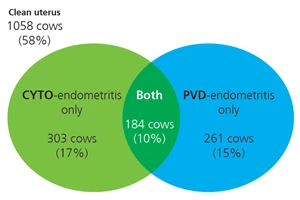Endometritis Reduces In Calf Rates
4 min read
Endometritis is an infection or inflammation of the cow's uterus, persistent beyond three weeks post-calving. It's diagnosed using a Metricheck™ device or by examining a smear of the uterine lining. Recent data reveals endometritis is prevalent in New Zealand, with an average of 25% of cows having metricheck-positive endometritis and 27% with CYTO-endometritis. This issue affects a cow's reproductive performance. Proper transition from late pregnancy to early lactation can reduce the risk, but some risk factors like under-conditioned cows or difficult calvings are preventable. If your cows have endometritis, discuss the best treatment methods with your vet.
Endometritis is an infection or inflammation of the uterus that persists beyond the third week after calving.
A study under the 'Pillars of a New Dairy System' estimated the prevalence of this disease in our pasture-based systems, and its negative effects on reproductive performance.
Endometritis is commonly diagnosed using a Metricheck™ device to examine material recovered from the vagina. This material is then scored on a 1 to 5 scale, ranging from clear oestrus-like mucus to thick foul-smelling pus (Figure 1). A score of 2 or more is used to identify 'dirty' cows with metricheck-positive endometritis.

Figure 1. Metricheck™ scores where 1 = clear mucus with no pus; 2 = mucus with flecks of pus, 3 = mucus with <50% pus; 4 = mucus with ≥50% pus; 5 = mucus with ≥50% pus and foul odour. Photos sourced from Dr S. McDougall (Anexa FVC).
Another form of endometritis can only be diagnosed under research conditions, whereby a small brush is passed through the cervix and a smear is taken of the uterine lining (the endometrium).

Figure 2. Photograph of a microscope slide prepared from a smear of the uterine lining (the endometrium) used to diagnose CYTO-endometritis.
The smear is examined under the microscope to count the number of neutrophils, which are immune cells that indicate inflammation likely as a result of bacterial infection (Figure 2).
If more than 2% of the cells present are neutrophils at four weeks before mating start date, then the cow is diagnosed with cytological (CYTO)-endometritis.
Until recently, there was only limited data on the prevalence of endometritis in New Zealand herds. This changed with a 2015 Cognosco-led study involving 1,806 cows across 100 herds in the Waikato and Canterbury regions.

Figure 3. The number and percentage of cows with metricheck-positive endometritis (blue), CYTO-endometritis (green), or both forms (green/blue) at four weeks before mating start date. A study population consisted of 1,806 randomly selected cows from 100 herds in Waikato and Canterbury.
A subset of cows from each herd were assessed for both forms of endometritis about four weeks before mating start date. On average, 25% of cows were diagnosed with metricheck-positive endometritis, whereas 27% had CYTO-endometritis (Figure 3).
The higher the Metricheck™ score, the greater the likelihood of a cow also having CYTO-endometritis (Table 1). For example, over half of the cows with Metricheck™ scores of 3 or more also tested positive for CYTO-endometritis. Overall, 10% of cows tested had both forms of endometritis, leaving only 58% of cows “clean” four weeks out from the start of mating (Figure 3).
Conception rates declined as Metricheck™ score increased, which resulted in lower 3- and 6-week In-Calf rates (Table 1). In this study, reproductive performance was reduced in cows diagnosed with a Metricheck™ score of 3 or more (Table 1), and in cows with CYTO-endometritis (Table 2). Moreover, cows that had both forms of endometritis had poorer reproductive performance than cows with only one of these conditions.
Table 1: Relationship between Metricheck™ score at four weeks before mating start date and reproductive performance
| MetricheckTM score |
|||||
| 'clean' | 'dirty' | ||||
| Score | 1 | 2 | 3 | 4 or 5 | Significance (P-value) |
| No. of cows | 1361 | 317 | 72 | 56 | |
| % of cows | 75% | 18% | 4% | 3% | |
| % of cows with CYTO-endometritis | 22% | 34% | 54% | 68% | |
| 3-week submission rate | 88% | 87% | 91% | 80% | 0.30 |
| 1st-service conception rate | 53% | 55% | 48% | 32% | 0.05 |
| 3-week In-Calf rate | 53% | 53% | 47% | 35% | 0.05 |
| 6-week In-Calf rate | 76% | 74% | 69% | 50% | <0.01 |
| CYTO-endometritis status | |||
| 'clean' | 'dirty' | ||
| <2% Neutrophils | ≥2% Neutrophils | Significance (P-value) | |
| No. of cows | 1318 | 488 | |
| % of cows | 73% | 27% | |
| 3-week submission rate | 89% | 84% | <0.01 |
| 1st-service conception rate | 55% | 46% | <0.01 |
| 3-week In-Calf rate | 55% | 44% | <0.01 |
| 6-week In-Calf rate | 76% | 68% | <0.01 |
The prevalence of either metricheck-positive or CYTO-endometritis varied significantly between herds, ranging from as little as 5% to as many as 65% of cows in the herd affected. We believe that this related to how well the cows were transitioned from late pregnancy through to early lactation; the high-risk period for health disorders that delay reproductive recovery to a state that can support pregnancy.
First-lactation heifers, animals from large herds (>800 cows), late calvers, or cows that had delivered a bull calf were more likely to develop metricheck-positive endometritis. These results align with overseas research that also demonstrated that cows with retained fetal membranes, assisted or difficult calving, or stillbirths were most at risk. Furthermore, in previous NZ studies, endometritis was more likely to occur in under-conditioned cows with a body condition score (BCS) of 4 or less at calving.
Since many of these disorders are preventable (e.g. under-conditioned cows, difficult calvings), optimal transition cow management will help to minimise the number of cows in a herd with endometritis.
However, even with the best transition management systems, some cows will still have endometritis. Optimal diagnosis and treatment approaches for your farm should be discussed with your vet. On-label intrauterine antibiotics have been proven to increase reproductive performance in metricheck-positive cows compared with leaving them untreated.
For more information on this study go to: McDougall, S.; Aberdein, D.; Bates, A.; Burke, C.R. 2020. Prevalence of endometritis diagnosed by vaginal discharge scoring or uterine cytology in dairy cows and herds. Journal of Dairy Science, 103:6411-6521. https://doi.org/10.3168/jds.2019-18048
Now’s the perfect time to check in, plan, and set up for a strong season. We’ve pulled together smart tips and tools to help you stay ahead all winter long.
Whether you prefer to read, listen, or download handy guides, we’ve got you covered with trusted tools to support your journey every step of the way.